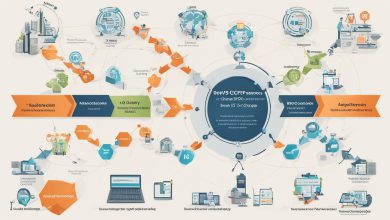
As organizations continue to embrace the principles of DevOps, security has become a critical consideration in the development and operations processes. In this regard, security automation plays a pivotal role in ensuring a streamlined and effective DevSecOps strategy. Security automation enhances the security posture of the organization by automating security practices and tools within the DevOps pipeline. In this section, we will examine the importance of security automation in a DevSecOps strategy and its impact on securing the business.
Key Takeaways
- Security automation plays a pivotal role in enhancing the effectiveness of DevSecOps practices
- Automated security measures streamline security practices, improve efficiency, and reduce the reliance on manual intervention
- Integrating security automation into the DevOps workflow helps to ensure continuous security throughout the development and operations processes
Understanding DevSecOps and its Key Components
DevSecOps is an approach to software development that integrates security into the DevOps workflow. It involves collaboration among development, security, and operations teams to streamline the software development process. The primary goal of DevSecOps is to ensure the security of the application throughout the development cycle and minimize vulnerabilities that could lead to security breaches.
The heartbeat of DevSecOps lies in the integration of security automation into the development pipeline. With security automation, teams can identify and fix security flaws in real-time, rather than waiting for security experts to identify vulnerabilities. Automating security measures ensures continuous security throughout the development and operations processes.
Key Components of a DevSecOps Strategy
A successful DevSecOps strategy involves several key components:
| Component | Description |
|---|---|
| Continuous Integration/Continuous Delivery (CI/CD) | CI/CD integrates automated testing, continuous deployment, and monitoring into the development workflow. |
| Infrastructure as Code (IaC) | IaC allows teams to automate the configuration and management of infrastructure using code. |
| Secure Coding Practices | Secure coding practices ensure that developers write code with security in mind from the outset. |
| Automated Security Measures | Automated security measures streamline security practices, improve efficiency, and reduce the reliance on manual intervention. |
Of these components, automated security measures are the most critical aspect of DevSecOps. Without automation, it is nearly impossible to manage the complexity and scale of security in a modern software development cycle. Automated security measures act as the heartbeat of DevSecOps and ensure continuous security throughout the development and operations processes.
The Benefits of Security Automation in DevSecOps
When it comes to securing DevOps processes, automated security measures can make all the difference. By incorporating security automation in a DevSecOps strategy, organizations can streamline their security practices, improve overall efficiency, and reduce the reliance on manual intervention. Automated security practices also enable teams to focus more on proactive security measures instead of defensive ones.
Security automation can enhance the overall security posture of an organization by ensuring that security measures are continuously incorporated throughout development and operations processes. By enforcing security measures at every stage of the pipeline, the risk of security breaches can be significantly reduced.
Furthermore, security automation can help organizations avoid common security pitfalls, such as human error and misconfigurations. Automated security measures can also identify and remediate security vulnerabilities faster, reducing the time required to address potential threats.
Overall, implementing security automation in a DevSecOps strategy can lead to a vast improvement in the security of the organization, enabling teams to focus on delivering business value and innovation without sacrificing security.
Implementing Security Automation in DevSecOps
Integrating security automation into a DevSecOps environment requires careful planning and execution to ensure a smooth and effective implementation. There are various approaches and technologies available that can be used to automate security practices and secure DevOps processes.
Automating Security Practices: One approach to implementing security automation in DevSecOps is by automating security practices such as vulnerability scanning, web application firewall rules, and compliance checks. This helps reduce the manual workload and improves the efficiency of the DevOps pipeline.
Securing DevOps Processes: Another aspect of implementing security automation in DevSecOps is securing the DevOps processes themselves. This includes using automated testing and deployment tools, as well as incorporating security controls into the automation workflow.
Best Practices for Implementing Security Automation in DevSecOps
When implementing security automation in DevSecOps, it is important to follow best practices to ensure a seamless integration and maximum impact on security. Some best practices include:
- Start with a well-defined security policy and clear security objectives.
- Ensure security automation is fully integrated into the DevOps workflow, rather than an afterthought.
- Use automation tools and technologies that are specifically designed for security automation.
- Implement continuous monitoring and reporting to ensure ongoing effectiveness and to identify any issues or areas for improvement.
By following these best practices, organizations can successfully implement security automation in their DevSecOps strategy and achieve a more efficient and secure DevOps pipeline.
Overcoming Challenges in Security Automation
Automating security practices in a DevSecOps workflow can be challenging. The implementation of security automation requires careful planning and execution to ensure seamless integration into the workflow.
One common challenge is the lack of alignment between automation and the DevOps workflow. To overcome this challenge, it is essential to identify areas where security automation can be integrated into the workflow. By prioritizing the integration of security automation into the DevOps pipeline, you can ensure that it is aligned with the workflow and helps to secure DevOps processes.
Another challenge is the reliance on manual intervention. Manual processes and procedures can be time-consuming and error-prone. To overcome this challenge, it is crucial to identify areas where security automation can replace manual processes. By automating these processes, you can streamline security practices and improve efficiency.
Best practices for Automating DevSecOps Workflow
- Start with small automation projects and gradually scale up.
- Ensure that automation is integrated into the DevOps pipeline.
- Automate repeatable processes and tasks.
- Ensure that automation is secure and auditable.
- Collaborate with the development and operations teams to identify areas for automation.
By following these best practices, you can overcome the challenges of implementing security automation in a DevSecOps environment and create a more effective and efficient workflow.
Tools and Technologies for Security Automation
Implementing security automation in a DevSecOps strategy requires the use of robust tools and technologies that can automate security practices seamlessly. These tools can help identify vulnerabilities, enforce compliance, and remediate security issues in real-time.
Here are some popular tools and technologies used for security automation in DevSecOps:
| Tool/Technology | Description |
|---|---|
| Ansible | A popular tool used for automating security configuration management. It allows teams to ensure that all systems are configured and secured to meet compliance requirements. |
| Terraform | A tool that enables teams to manage infrastructure as code. It provides a framework for automating infrastructure tasks and deploying secure infrastructure with ease. |
| Trufflehog | A tool that scans Git repositories for secrets and sensitive information. It helps teams identify potential vulnerabilities and take preventive measures to protect sensitive information. |
Other tools and technologies for security automation include DevOps automation platforms like Jenkins, CircleCI, and Travis CI, which can integrate with security automation tools to provide a seamless and secure DevSecOps workflow.
When choosing a security automation tool, it’s important to consider factors such as ease of integration, flexibility, scalability, and cost-effectiveness. Teams should also evaluate the tool’s capabilities to ensure that it meets their specific security requirements.
The Benefits of Security Automation in DevSecOps
Security automation can bring significant benefits to a DevSecOps strategy, improving the effectiveness of security practices and safeguarding against potential threats. By automating security measures, developers can streamline security practices, reduce the reliance on manual intervention, and improve overall efficiency.
Automated security measures can also enhance the overall security posture of the organization by identifying and mitigating potential vulnerabilities before they become more significant issues. This can help prevent data breaches, costly downtime, and other security incidents that can negatively impact the business.
Moreover, security automation enables teams to ensure continuous security throughout the development and operations processes, making it easier to secure DevOps processes overall. By integrating security into the workflow, organizations can proactively identify and address security issues, rather than waiting for them to arise.
Measuring the Success of Security Automation in DevSecOps
Measuring the effectiveness of security automation is an essential component of effective DevSecOps. Effective DevSecOps processes ensure that security is integrated into every aspect of the development and operations pipeline and continuously optimized and refined over time.
To measure the success of security automation, organizations may track metrics such as the number of security incidents detected and resolved, the time taken to identify and resolve security issues, and the level of automation used in security practices. By monitoring these metrics, companies can evaluate the impact of security automation on the overall security of their DevOps processes and identify areas for improvement.
Overall, security automation is a crucial aspect of any DevSecOps strategy. By automating security measures, organizations can improve the efficiency and effectiveness of security practices, enhance the overall security posture of the business, and ensure continuous security throughout the DevOps pipeline. By measuring the success of security automation, companies can ensure that their DevSecOps initiatives are continuously optimized and refined for maximum effectiveness.
Conclusion
In conclusion, security automation is the heartbeat of an effective DevSecOps strategy. As organizations strive to secure their business, it is essential to integrate security practices into the DevOps workflow. By implementing security automation, businesses can continuously streamline security practices, improve efficiency, and reduce the reliance on manual intervention.
Through security automation, organizations can enhance the overall security posture and protect themselves from potential cyber threats. Therefore, tech leaders must prioritize security automation in their DevSecOps initiatives to realize the full benefits of an effective DevSecOps strategy.
Stay Protected
By incorporating security automation in DevSecOps, businesses can secure their DevOps processes and build a robust security framework. It is essential to align automation with the overall workflow and ensure seamless integration of security practices throughout the pipeline. Measuring the success of security automation is crucial to optimize and continuously improve security practices.
Investing in the right tools and technologies for security automation can streamline security practices and enhance the overall security of the DevOps workflow. It is imperative to overcome challenges faced during implementation and align automation with the overall workflow.
Therefore, we encourage tech leaders to prioritize security automation as the heartbeat of their DevSecOps strategy and build a secure and robust framework to protect their business.
FAQ
Q: What is security automation and why is it important in a DevSecOps strategy?
A: Security automation refers to the use of automated processes and technologies to streamline security practices in a DevSecOps strategy. It is important because it enhances the effectiveness of DevSecOps practices by ensuring continuous security throughout the development and operations processes. Security automation plays a critical role in securing the business and protecting sensitive data.
Q: What is DevSecOps and how does it integrate security into the DevOps workflow?
A: DevSecOps is a methodology that integrates security into the DevOps workflow. It emphasizes the importance of security throughout the software development lifecycle. By integrating security practices and considerations from the beginning, DevSecOps ensures that security is not an afterthought but a fundamental aspect of the development and operations processes.
Q: What are the benefits of security automation in DevSecOps?
A: Incorporating security automation in a DevSecOps strategy offers several benefits. It streamlines security practices, improves efficiency, and reduces the reliance on manual intervention. Automated security measures help identify and mitigate vulnerabilities at a faster pace, enhancing the overall security posture of the organization.
Q: How can security automation be implemented in a DevSecOps environment?
A: Implementing security automation in a DevSecOps environment involves leveraging various approaches and technologies. It requires automating security practices and securing DevOps processes. Best practices include integrating security automation seamlessly into the workflow, using automated testing tools, and implementing robust access controls.
Q: What are the common challenges in implementing security automation in DevSecOps?
A: Implementing security automation in DevSecOps may face challenges such as aligning automation with the overall workflow, ensuring smooth integration of security practices, and overcoming resistance to change. Solutions include proper planning and communication, training teams on security automation, and selecting tools that are compatible with existing infrastructure.
Q: What are some popular tools and technologies for security automation in DevSecOps?
A: There are various tools and technologies available for security automation in a DevSecOps environment. Some popular ones include container security tools like Docker Security Scanning, vulnerability scanning tools like Nessus, continuous integration and delivery platforms like Jenkins, and security orchestration and automation tools like Ansible and Puppet.
Q: How can the success of security automation in DevSecOps be measured?
A: The success and effectiveness of security automation in DevSecOps can be measured using key metrics and indicators. These include the number of vulnerabilities detected and addressed, the time taken to address security incidents, and the reduction in the number of security breaches. Continuous monitoring and evaluation help in identifying areas for improvement.
Q: In conclusion, why is security automation the heartbeat of an effective DevSecOps strategy?
A: Security automation is the heartbeat of an effective DevSecOps strategy because it ensures continuous security throughout the entire development and operations processes. By integrating security practices from the beginning, organizations can enhance their overall security posture and protect sensitive data. Prioritizing security automation in DevSecOps initiatives is crucial for the success and resilience of the business.







